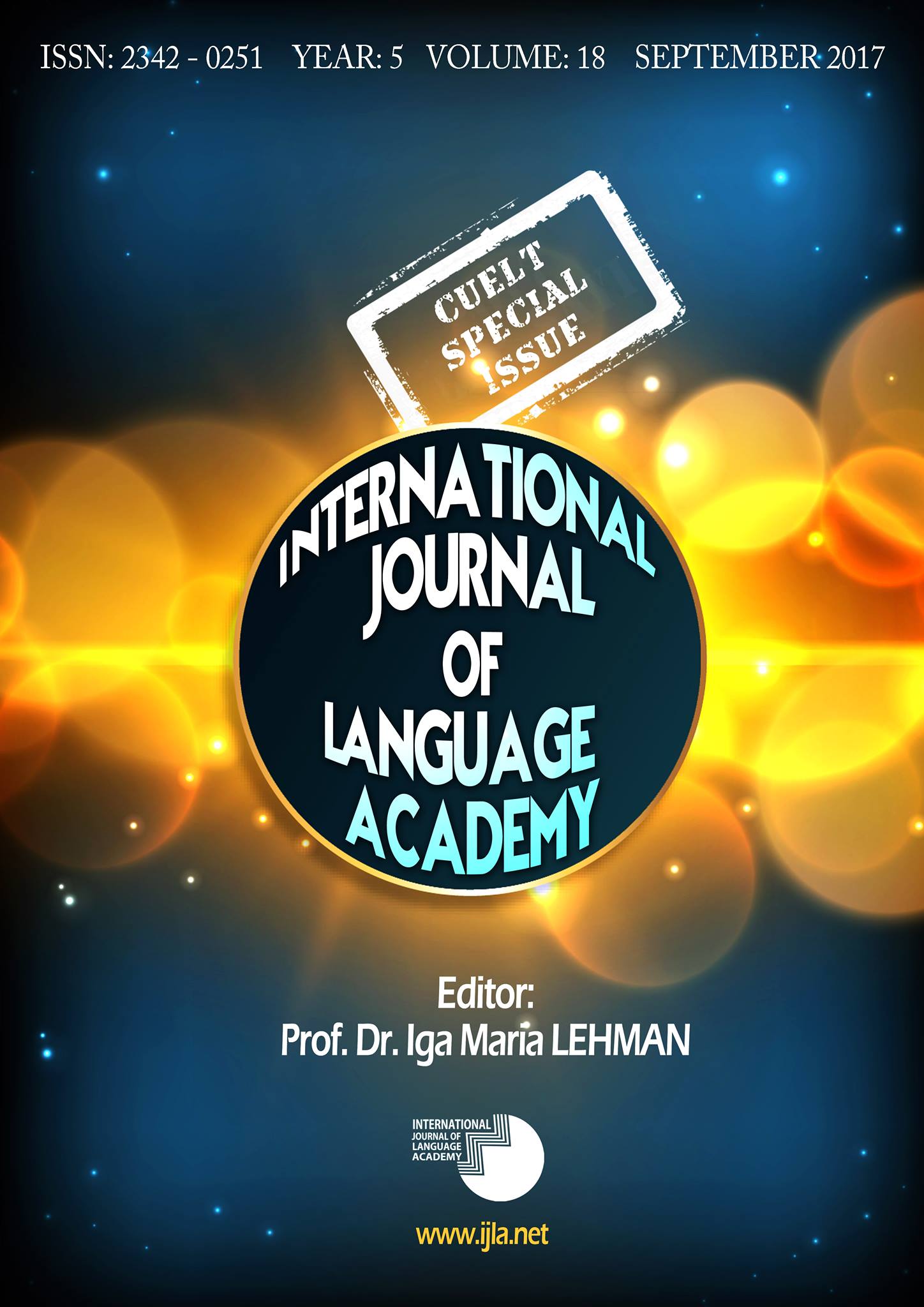İNGİLİZCE ÖĞRENEN TÜRK ÖĞRENCİLERİN DEYİMSEL FİİLLERİ VEYA EŞ ANLAMLI TEK KELİMELİK FİİLLERİ KULLANMA TERCİHLERİ
Author :
Abstract
Bu çalışma İngilizce öğrenen Türk öğrencilerin, eş anlamlı tek kelimelik fiillerin mevcut olduğu durumda, LOCNESS adlı bütünceden seçilmiş en yaygın olarak kullanılan deyimsel fiilleri ne ölçüde tercih ettiklerini araştırmaktadır. Orta Doğu Teknik Üniversitesi’nin Yabancı Diller Eğitimi Bölümü’nde öğrenim gören rastgele seçilmiş 30 ikinci sınıf öğrencisine iki farklı test uygulanmıştır. 15 cümleye yer verilen boşluk doldurma gerektiren ilk testte, katılımcılar hangi derecede tek kelimelik bir fiili ya da deyimsel fiili tercih ettiklerini belirtmişlerdir. Serbest üretime dayanan ve ilk testteki deyimsel fiillerin Türkçe karşılıkları göz önünde bulundurularak oluşturulan çeviri testi de aynı sayıda cümle içermiştir. Çalışmanın sonuçları katılımcıların gerçek anlamlı deyimsel fiillere kıyasla, sahip oldukları anlamsal karmaşadan ötürü mecazi anlamlı olanları kullanmaktan daha fazla kaçındıklarını göstermiştir. Katılımcıların çeviri testinde tek kelimelik fiilleri daha fazla sıklıkta kullanması, test tipinin öğrencilerin deyimsel fiilleri tercih etmeleri üzerinde etkili olduğunu göstermiştir. Ayrıca her iki test tipinde de katılımcıların deyimsel fiilleri kullanmaktan büyük ölçüde kaçınmadıkları saptanmıştır.
Keywords
Abstract
This study aims to investigate the preferences of Turkish EFL sophomores regarding the usage of most common phrasal verbs in Louvain Corpus of Native English Essays (LOCNESS) in the case of coexistent synonymous one-word verbs. 30 participants that are currently enrolled at the Department of Foreign Language Education, at METU were given two tests. A preference test (in which each item required learners to indicate to what degree they opted whether a phrasal verb or one – word on a five point scale) and translation test (based on free production as well as being composed of Turkish equivalents of selected phrasal verbs in preference test) including 15 items were administered. The results showed that figurative phrasal verbs resulted in being avoided by learners more than literal phrasal verbs probably due to their semantic complexity. In addition, task type was found to affect the preferences of learners regarding the usage of phrasal verbs since one-word verbs appeared more frequently in translation task. Finally, it was revealed that Turkish EFL sophomores did not avoid phrasal verbs to a greater extent in both test types.
Keywords
- Akbari, O. (2009). A corpus-based study on Malaysian ESL learners’ use of phrasal verbs in narrative compositions (Unpublished Doctoral Dissertation). Universiti Putra Malaysia, Serdang.
- Cornell, A. (1985). Realistic goals in teaching and learning phrasal verbs. IRAL- International Review of Applied Linguistics in Language Teaching, 23(1-4), 269
- Dagut, M., & Laufer, B. (1985). Avoidance of phrasal verbs—A case for contrastive analysis. Studies in Second Language Acquisition, 7(1), 73-79.
- Darwin, C. M., & Gray, L. S. (1999). Going after the phrasal verb: An alternative approach to classification. TESOL Quarterly, 33(1), 65-83.
- Dauzón Arias, K., & Coto Lira, Y. (2013). The use and teaching of phrasal verbs at the advanced level on the BA in English language (Unpublished doctoral dissertation). University of Veracruz, Mexico.
- Dixon, R. (1982). The grammar of English phrasal verbs. Australian Journal of Linguistics, 2, 1-42.
- Houshyar, S. & Talebinezhad, M. (2012). Study on avoidance behaviour among Persian EFL learners: phrasal verbs in focus. Greener Journal of Educational Research, 3(6), 238-248.
- Hulstijn, J. H., & Marchena, E. (1989). Avoidance. Studies in Second Language Acquisition, 11(03), 241-255.
- Kamimoto, T., Shimura, A., & Kellerman, E. (1992). A second language classic reconsidered- the case of Schachters avoidance. Interlanguage studies bulletin (Utrecht), 8(3), 251-277.
- Kleinmann, H. H. (1977). Avoidance behavior in adult second language acquisition. Language Learning, 27(1), 93-107.
- Laufer, B., & Eliasson, S. (1993). What causes avoidance in L2 learning: L1-L2 difference, L1-L2 similarity, or L2 complexity?. Studies in Second Language Acquisition, 15(1), 35-48.
- Li, W., Zhang, X., Niu, C., Jiang, Y., & Srihari, R. (2003). An expert lexicon approach to identifying English phrasal verbs. Proceedings of the 41st Annual Meeting on Association for Computational Linguistics- ACL 03, 513-520.
- Liao, Y., & Fukuya, Y. J. (2004). Avoidance of phrasal verbs: the case of Chinese learners of English. Language Learning, 54(2), 193-226.
- Quirk, R., Greenbaum, S., Leech, G., & Svartvik, J. (1985). A Comprehensive Grammar of the English Language. London, England: Longman.
- Schachter, J. (1974). An Error in Error Analysis1. Language learning, 24(2), 205-214.
- Selinker, L. (1972). Interlanguage. IRAL-International Review of Applied Linguistics in Language Teaching, 10(1-4), 209-232.
- Side, R. (1990). Phrasal verbs: Sorting them out. ELT Journal, 44(2), 144-152.
- Siyanova, A., & Schmitt, N. (2007). Native and nonnative use of multi-word vs. one-word verbs. IRAL-International Review of Applied Linguistics in Language Teaching,
- Sjo holm, K. (1995). The influence of crosslinguistic, semantic, and input factors on the





